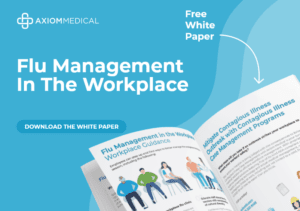Workplaces reported 2.6 million injury and illness cases and 5,190 total fatal injuries in 2021, an 8.9% increase compared to the prior year. How do we implement successful injury management to reduce recordable cases and workplace fatalities?
Injuries in the workplace are not uncommon. The risk of an injury or accident is always present whether, it’s a desk job or construction, both present hazards and are costly to employers and employees. The most common injuries are lifting, lowering, or carrying something, slips, trips, and falls. Workplace injuries are more common among young workers, with more than one-quarter of injuries occurring in their first year of employment.

The health and safety of employees should always be priority number one. Yet, workplace injuries are prevalent despite the best precautions and preventive measures. The key to minimizing the impact of such incidents lies in successful injury management. Here are six steps to successfully manage workplace injuries.
Step 1: Immediate Intervention & First Aid
When an injury occurs in the workplace, it is crucial to have a clear and well-communicated plan for handling employee injuries and illnesses. Employees should be trained and know how to respond to emergencies appropriately. Appoint those trained in first aid to care for the injured individual until medical professionals arrive. Quick and effective first aid response can significantly minimize the severity of injuries and improve recovery chances.
At Axiom Medical, we refer to the first hour after a workplace injury has occurred as the critical hour. Immediately reporting the injury to one of our licensed medical professionals for medical assessment and intervention will affect the employee’s recovery path, workers’ comp claims, OSHA recordability, and workplace morale.
Step 2: Immediate Injury Reporting
Ensure the incident is reported and documented after medical attention is given. Establish a transparent reporting process that encourages all employees to report workplace injuries, no matter how minor. The detailed report should include descriptions, pictures, and other relevant information.
A delay in reporting by even one day can increase recordability by 60%. Late reporting also risks injury exacerbation, increased clinic and ER costs, lost productivity, increased workers’ comp claims, and decreased workplace morale. Accurate injury reporting helps to analyze the root causes of the injury, identify trends, and implement preventive measures to avoid similar incidents in the future.
Step 3: Appropriate Medical Attention
After administering first aid, it is key to ensure that the injured employee receives appropriate medical attention. A simple first-aid case may become complicated if the injured employee has an underlying condition. Employees should be encouraged to visit a clinic or ER to assess the injury’s severity and determine an appropriate treatment plan. Any medical assessments, treatments, and progress records to help manage the injury should be kept and documented to form a return-to-work plan.
Axiom Medical’s team of licensed medical professionals is trained in injury case management and emergency medicine. Our team of nurse case managers completes a medical assessment with a full medical history review when assessing an injury. We manage cases in-house, keeping 70% of cases at the first aid level and, when appropriate, referring injured employees to seek additional care.
Step 4: Return-to-Work
Rehabilitating injured employees and facilitating their safe return to work is key to successful injury management. Work together with healthcare professionals, employees, and supervisors to develop personalized return-to-work plans. These plans should consider the employee’s physical and psychological needs. Slowly reintegrate them into their regular or modified duties and provide any necessary accommodations and support.
Our nurse case managers guide and support injured employees throughout their recovery process, ensuring their physical and psychological needs are met. We inform employers of their return status and manage all necessary documentation, such as FMLA forms.
Step 5: Incident Investigation
It is essential to understand what may have been the root cause of the incident and address it proactively to prevent future injuries. It is the employer’s responsibility to find out why the incident occurred. Analyze the factors contributing to the injury: equipment failure, unsafe work practices, inadequate training, or gaps in your safety policies.
Record details of the incident and interview the injured employee, if possible, and any witnesses to take the next steps to ensure the incident doesn’t reoccur. Carry out any necessary countermeasures to eliminate or mitigate future risks and hazards.
Step 6: Communication and Continuous Improvement
Workplace injury management is a continuing process that requires continuous improvement. Safety policies, procedures, and training should be updated and reviewed regularly to ensure they match with the latest industry standards.
Have a safety forward workplace culture by promoting active participation with safety initiatives, reporting hazards, and contributing ideas for improvement. Employees want to feel heard. When they see other employees being injured on the job, it can lead to concerns. Having excellent communication in the workplace can help.
Successful workplace injury management relies on a proactive approach that prioritizes employee health and safety and promotes a safety driven workplace culture. With these six steps, employers can effectively manage workplace injuries, minimize their impact, and promote a safe working environment.
For over two decades, Axiom Medical has been in the business of managing worker health. Our team supports employers and employees throughout the injury management process. Reach out to us today to learn how we can partner together to keep your workplace safe and workers healthy.
Charli Pedersen is a published writer featured on Axiom Medical’s blog. She holds a bachelor’s degree in English, Professional and Technical Writing, and has experience creating content for businesses and non-profit organizations.










